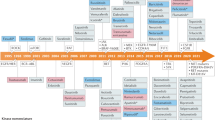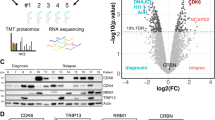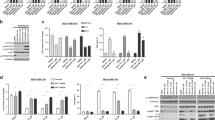Abstract
Resistance to the BCR-ABL tyrosine kinase inhibitor imatinib poses a pressing challenge in treating chronic myeloid leukemia (CML). This resistance is often caused by point mutations in the ABL kinase domain or by overexpression of LYN. The second-generation BCR-ABL inhibitor INNO-406 is known to inhibit most BCR-ABL mutants and LYN efficiently. Knowledge of its full target spectrum would provide the molecular basis for potential side effects or suggest novel therapeutic applications and possible combination therapies. We have performed an unbiased chemical proteomics native target profile of INNO-406 in CML cells combined with functional assays using 272 recombinant kinases thereby identifying several new INNO-406 targets. These include the kinases ZAK, DDR1/2 and various ephrin receptors. The oxidoreductase NQO2, inhibited by both imatinib and nilotinib, is not a relevant target of INNO-406. Overall, INNO-406 has an improved activity over imatinib but a slightly broader target profile than both imatinib and nilotinib. In contrast to dasatinib and bosutinib, INNO-406 does not inhibit all SRC kinases and most TEC family kinases and is therefore expected to elicit fewer side effects. Altogether, these properties may make INNO-406 a valuable component in the drug arsenal against CML.
This is a preview of subscription content, access via your institution
Access options
Subscribe to this journal
Receive 12 print issues and online access
$259.00 per year
only $21.58 per issue
Buy this article
- Purchase on Springer Link
- Instant access to full article PDF
Prices may be subject to local taxes which are calculated during checkout





Similar content being viewed by others
References
Kimura S, Naito H, Segawa H, Kuroda J, Yuasa T, Sato K et al. NS-187, a potent and selective dual Bcr-Abl/Lyn tyrosine kinase inhibitor, is a novel agent for imatinib-resistant leukemia. Blood 2005; 106: 3948–3954.
Wu J, Meng F, Kong LY, Peng Z, Ying Y, Bornmann WG et al. Association between imatinib-resistant BCR-ABL mutation-negative leukemia and persistent activation of LYN kinase. J Natl Cancer Inst 2008; 100: 926–939.
Donato NJ, Wu JY, Stapley J, Gallick G, Lin H, Arlinghaus R et al. BCR-ABL independence and LYN kinase overexpression in chronic myelogenous leukemia cells selected for resistance to STI571. Blood 2003; 101: 690–698.
Ptasznik A, Nakata Y, Kalota A, Emerson SG, Gewirtz AM . Short interfering RNA (siRNA) targeting the Lyn kinase induces apoptosis in primary, and drug-resistant, BCR-ABL1(+) leukemia cells. Nat Med 2004; 10: 1187–1189.
Pan J, Quintas-Cardama A, Manshouri T, Cortes J, Kantarjian H, Verstovsek S . Sensitivity of human cells bearing oncogenic mutant kit isoforms to the novel tyrosine kinase inhibitor INNO-406. Cancer Sci 2007; 98: 1223–1225.
Yokota A, Kimura S, Masuda S, Ashihara E, Kuroda J, Sato K et al. INNO-406, a novel BCR-ABL/Lyn dual tyrosine kinase inhibitor, suppresses the growth of Ph+ leukemia cells in the central nervous system, and cyclosporine A augments its in vivo activity. Blood 2007; 109: 306–314.
Bantscheff M, Eberhard D, Abraham Y, Bastuck S, Boesche M, Hobson S et al. Quantitative chemical proteomics reveals mechanisms of action of clinical ABL kinase inhibitors. Nat Biotechnol 2007; 25: 1035–1044.
Rix U, Hantschel O, Durnberger G, Remsing Rix LL, Planyavsky M, Fernbach NV et al. Chemical proteomic profiles of the BCR-ABL inhibitors imatinib, nilotinib, and dasatinib reveal novel kinase and nonkinase targets. Blood 2007; 110: 4055–4063.
Remsing Rix LL, Rix U, Colinge J, Hantschel O, Bennett KL, Stranzl T et al. Global target profile of the kinase inhibitor bosutinib in primary chronic myeloid leukemia cells. Leukemia 2009; 23: 477–485.
Talpaz M, Shah NP, Kantarjian H, Donato N, Nicoll J, Paquette R et al. Dasatinib in imatinib-resistant Philadelphia chromosome-positive leukemias. N Engl J Med 2006; 354: 2531–2541.
Hantschel O, Rix U, Schmidt U, Burckstummer T, Kneidinger M, Schutze G et al. The Btk tyrosine kinase is a major target of the Bcr-Abl inhibitor dasatinib. Proc Natl Acad Sci USA 2007; 104: 13283–13288.
Maxwell SA, Kurzrock R, Parsons SJ, Talpaz M, Gallick GE, Kloetzer WS et al. Analysis of P210bcr-abl tyrosine protein kinase activity in various subtypes of Philadelphia chromosome-positive cells from chronic myelogenous leukemia patients. Cancer Res 1987; 47: 1731–1739.
Wang X, Mader MM, Toth JE, Yu X, Jin N, Campbell RM et al. Complete inhibition of anisomycin and UV radiation but not cytokine induced JNK and p38 activation by an aryl-substituted dihydropyrrolopyrazole quinoline and mixed lineage kinase 7 small interfering RNA. J Biol Chem 2005; 280: 19298–19305.
Winger JA, Hantschel O, Superti-Furga G, Kuriyan J . The structure of the leukemia drug imatinib bound to human quinone reductase 2 (NQO2). BMC Struct Biol 2009; 9: 7.
Corless CL, Schroeder A, Griffith D, Town A, McGreevey L, Harrell P et al. PDGFRA mutations in gastrointestinal stromal tumors: frequency, spectrum and in vitro sensitivity to imatinib. J Clin Oncol 2005; 23: 5357–5364.
Horio T, Hamasaki T, Inoue T, Wakayama T, Itou S, Naito H et al. Structural factors contributing to the Abl/Lyn dual inhibitory activity of 3-substituted benzamide derivatives. Bioorg Med Chem Lett 2007; 17: 2712–2717.
Schirle M, Heurtier M-A, Kuster B . Profiling core proteomes of human cell lines by one-dimensional PAGE and liquid chromatography-tandem mass spectrometry. Mol Cell 2003; 2: 1297–1305.
Smith DL, Evans CA, Pierce A, Gaskell SJ, Whetton AD . Changes in the proteome associated with the action of Bcr-Abl tyrosine kinase are not related to transcriptional regulation. Mol Cell Proteomics 2002; 1: 876–884.
Villalva C, Sorel N, Bonnet ML, Guilhot J, Mayeur-Rousse C, Guilhot F et al. Neutrophil gelatinase-associated lipocalin expression in chronic myeloid leukemia. Leuk Lymphoma 2008; 49: 984–988.
Leng X, Lin H, Ding T, Wang Y, Wu Y, Klumpp S et al. Lipocalin 2 is required for BCR-ABL-induced tumorigenesis. Oncogene 2008; 27: 6110–6119.
Day E, Waters B, Spiegel K, Alnadaf T, Manley PW, Buchdunger E et al. Inhibition of collagen-induced discoidin domain receptor 1 and 2 activation by imatinib, nilotinib and dasatinib. Eur J Pharmacol 2008; 599: 44–53.
Skorski T, Nieborowska-Skorska M, Szczylik C, Kanakaraj P, Perrotti D, Zon G et al. C-RAF-1 serine/threonine kinase is required in BCR/ABL-dependent and normal hematopoiesis. Cancer Res 1995; 55: 2275–2278.
Weisberg E, Wright RD, Jiang J, Ray A, Moreno D, Manley PW et al. Effects of PKC412, nilotinib, and imatinib against GIST-associated PDGFRA mutants with differential imatinib sensitivity. Gastroenterology 2006; 131: 1734–1742.
Pasquale EB . Eph-ephrin bidirectional signaling in physiology and disease. Cell 2008; 133: 38–52.
Lackmann M, Boyd AW . Eph, a protein family coming of age: more confusion, insight, or complexity? Sci Signal 2008; 1: re2.
Ireton RC, Chen J . EphA2 receptor tyrosine kinase as a promising target for cancer therapeutics. Curr Cancer Drug Targets 2005; 5: 149–157.
Jandhyala DM, Ahluwalia A, Obrig T, Thorpe CM . ZAK: a MAP3Kinase that transduces Shiga toxin- and ricin-induced proinflammatory cytokine expression. Cell Microbiol 2008; 10: 1468–1477.
Huang CY, Chueh PJ, Tseng CT, Liu KY, Tsai HY, Kuo WW et al. ZAK re-programs atrial natriuretic factor expression and induces hypertrophic growth in H9c2 cardiomyoblast cells. Biochem Biophys Res Commun 2004; 324: 973–980.
Cho YY, Bode AM, Mizuno H, Choi BY, Choi HS, Dong Z . A novel role for mixed-lineage kinase-like mitogen-activated protein triple kinase alpha in neoplastic cell transformation and tumor development. Cancer Res 2004; 64: 3855–3864.
Niwa T, Asaki T, Kimura S . NS-187 (INNO-406), a Bcr-Abl/Lyn dual tyrosine kinase inhibitor. Anal Chem Insights 2007; 2: 93–106.
Acknowledgements
This study was supported by the Leukemia and Lymphoma Society (Grant number 5081–05), the Austrian Federal Ministry for Science and Research (BMWF) under the GEN-AU program (GZ200.142/I-VI/I/2006 and GZ200.145/I-VI/I/2006), the Austrian Science Fund (FWF; P18737-B11), the Austrian National Bank (ÖNB) and the Austrian Academy of Sciences (ÖAW). We thank Norbert Venturini for preparation of the SDS–PAGE gels and Florian Grebien for helpful discussions.
Author information
Authors and Affiliations
Corresponding author
Additional information
Supplementary Information accompanies the paper on the Leukemia website (http://www.nature.com/leu)
Supplementary information
Rights and permissions
About this article
Cite this article
Rix, U., Remsing Rix, L., Terker, A. et al. A comprehensive target selectivity survey of the BCR-ABL kinase inhibitor INNO-406 by kinase profiling and chemical proteomics in chronic myeloid leukemia cells. Leukemia 24, 44–50 (2010). https://doi.org/10.1038/leu.2009.228
Received:
Revised:
Accepted:
Published:
Issue Date:
DOI: https://doi.org/10.1038/leu.2009.228
Keywords
This article is cited by
-
Identification of druggable regulators of cell secretion via a kinome-wide screen and high-throughput immunomagnetic cell sorting
Nature Biomedical Engineering (2023)
-
DDR1 and DDR2: a review on signaling pathway and small molecule inhibitors as an anticancer agent
Medicinal Chemistry Research (2021)
-
Mechanisms of the Cardiac Myocyte-Damaging Effects of Dasatinib
Cardiovascular Toxicology (2020)
-
Multikinase Abl/DDR/Src Inhibition Produces Optimal Effects for Tyrosine Kinase Inhibition in Neurodegeneration
Drugs in R&D (2019)
-
Past, present, and future of Bcr-Abl inhibitors: from chemical development to clinical efficacy
Journal of Hematology & Oncology (2018)



